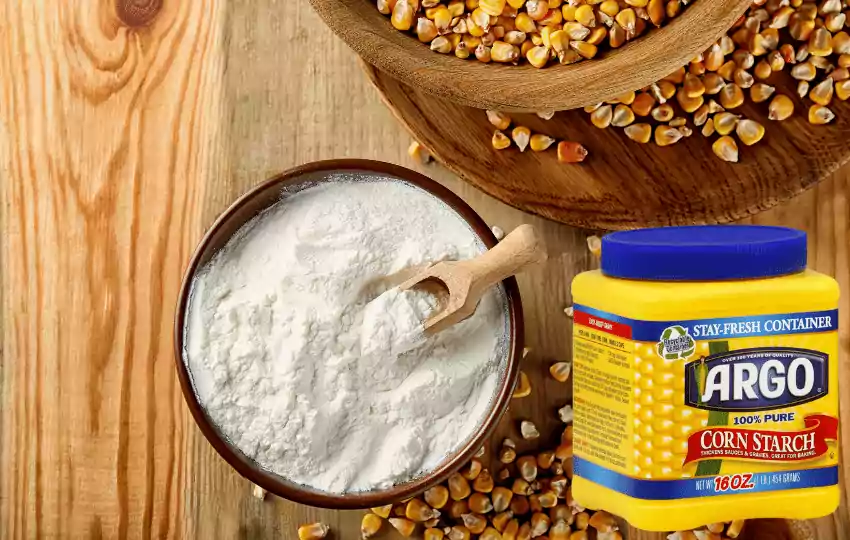Cornstarch and baking powder are both used for making batter and deep-fried, but can I use cornstarch instead of baking powder? Is this replacement a good choice?
Many people misunderstood both ingredients and went wrong with the ultimate result. Because baking powder contains a small amount of cornstarch.
If you’re on the same page, then know in detail about both of them, and in the end, you’ll get a precise answer and also get to know the best substitute for baking powder as well.
Can I use cornstarch instead of baking powder?
So, can you use cornstarch instead of baking powder? Your answer is Big NO.
Because the reason is-
Cornstarch cannot be substituted for baking powder. Cornstarch thickens the batter, whereas baking powder only helps to leaven it. Cornstarch thickens mixes, but baking powder causes the dish to rise.
Baking powder contains a small amount of cornstarch, but this is not enough to thicken the batter. Baking powder is typically mixed with baking soda in recipes.
Baking soda is what causes the dish to actually rise. Without it, your cake or muffins would be dense and heavy.
So if you’re out of baking powder, you’re better off using baking soda in combination with another acid (such as lemon juice or vinegar). This will ensure that your baked goods turn out light and fluffy.
| Corn Starch instead of Baking Powder for Chicken Wings | No, but use it as a batter |
| Corn Starch instead of Baking Powder for Pancakes | NO |
| Corn Starch instead of Baking Powder for Cake | Use as an anticaking agent |
| Corn Starch instead of Baking Powder for Cookies | NO |
| Corn Starch instead of Baking Powder for Frying | Use only as a Batter |
| Corn Starch instead of Baking Powder for Fried Chicken | Use as Coat over chicken |
What is CornStarch?
Corn starch is a powder manufactured from the starchy endosperm of the corn kernel. The endosperm makes up about 70-80% of the kernel. The germ and bran make up the rest. Corn starch is extracted from the endosperm through a process of milling and sieving.
It is then bleached with chlorine dioxide to make it white.
Uses of Cornstarch?
Corn starch is used to thicken a variety of foods, including sauces, gravies, puddings, pie fillings, and even some baked items. Because it is twice as strong as wheat flour, less is required to reach the necessary thickness.
When mixed with water, corn starch forms a clear gel that can be used as a food adhesive or moldable glue. Corn starch is often used for substitute Kudzu, potato flour, and more.
What is Baking Powder?
Baking powder is a dried chemical leavening ingredient used to brighten baked foods. It is a mixture of an acid and a base, which react when wet to produce carbon dioxide gas. This reaction causes the batter or dough to rise, resulting in a lighter final product.
Baking powder is found in single-acting and double-acting forms. Single-acting baking powders react once they are wet, while double-acting baking powders react both when wet and when heated.
Baking powder is a necessary component of many fast breads and cakes. When utilized correctly, it can provide a light and airy finished product. However, if not used correctly, baking powder can cause baked goods to be dense and heavy.
Uses of Baking Powder?
Baking powder is a typical component in cake, cookie, and other baked goods recipes. It is a leavening agent that aids in the rise of the batter during baking. Baking powder contains an alkali, baking soda, and an acid, such as a cream of tartar.
When the powder and liquid ingredients are combined, the baking soda and acid react to form carbon dioxide gas. This gas causes the batter to expand, or rise, during baking.
Can you Replace Baking Powder with Cornstarch?
No, baking powder is composed of an acid and a base that react to produce carbon dioxide gas. Cornstarch does not contain either of these ingredients, so it cannot be used as a substitute for cornstarch either.
Baking powder is a leavening agent and also a thickening agent, which means that it helps to thicken sauces and prevent them from becoming too runny.
So while they may appear to be similar at first glance, cornstarch and baking powder are actually far different.
Now the question is…
What happens if you use cornstarch instead of baking powder?
Your baked goods will be dense and chewy if you use cornstarch instead of baking powder. Cornstarch is not a good substitute for baking powder because it doesn’t have the same leavening power. In fact, the dish you’re going to make is never leavening as it needs, and the cake becomes harder.
Baking powder is a double-acting leavening, which means that it contains both an acid and an alkali. These two compounds react to produce carbon dioxide gas, which aids in the rising of baked foods. Because cornstarch is simply starch, it lacks the leavening effect of baking powder.
Then…
What can I use if I don’t have baking powder?
1. Use Vinegar +BAKING SODA
If you do not have any baking powder, you can leaven your baked items with a combination of baking soda and vinegar.
Just substitute 1 teaspoon (5 grams) of baking soda and 2 tablespoons (30 ml) of vinegar for each 1 teaspoon (5 grams) of baking powder.
Be sure to add the vinegar to the wet ingredients first, and then add the baking soda. The mixture will fizz and foam so doesn’t be alarmed.
When substituting vinegar for baking powder in a recipe, you need to use 4 times as much vinegar as you would baking powder. For instance, if a recipe calls for 1 teaspoon of baking powder, use 4 tablespoons of vinegar.
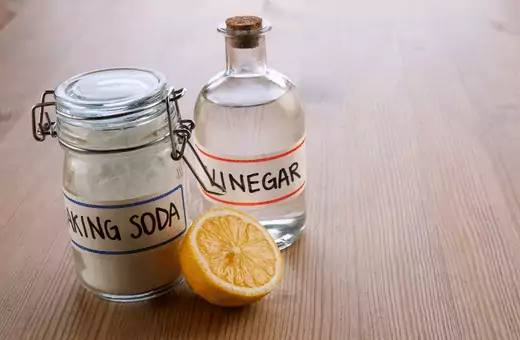
Vinegar is a weaker leavening agent than baking powder, so you need to use more of it to get the same results. Additionally, vinegar can add a tangy flavor to your baked goods, so keep that in mind when substituting it for baking powder.
If you don’t have any vinegar on hand, lemon juice will suffice. Just like with vinegar, you’ll need to use 4 times as much lemon juice as the recipe calls for baking powder. As an example, if a recipe called for 1 teaspoon of baking powder, you would use 4 tablespoons of lemon juice.
2. Use SOUR MILK+BAKING SODA
If you don’t have baking powder and need a quick substitute, combine sour milk and baking soda. This combination will work as a good leavener in your recipe, causing the finished product to rise.
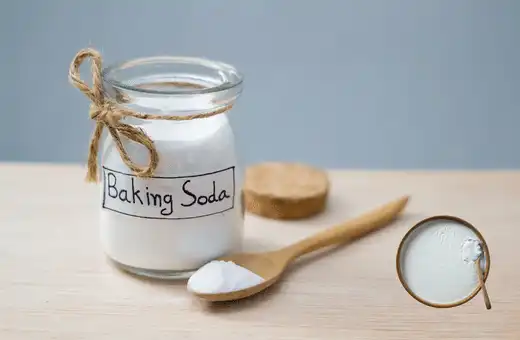
Simply substitute 1/4 teaspoon of baking soda for each cup of sour milk specified in the recipe. For example, if your recipe calls for 1 cup of sour milk, substitute 1 teaspoon of baking soda.
If you don’t have any sour milk on hand, you can make your own by adding a tablespoon of lemon juice or vinegar to regular milk. Let the mixture sit for 5 minutes before using it in your recipe.
3. Add LEMON JUICE + BAKING SODA
When you don’t have baking powder and need it to make a recipe, you can use a combination of lemon juice and baking soda instead. Just mix together 1 teaspoon (5 grams) of baking soda with 2 teaspoons (10 grams) of lemon juice.
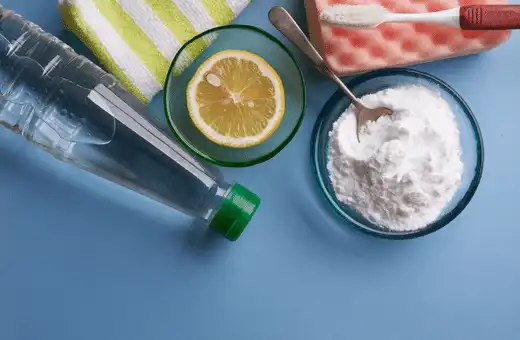
This is the equivalent of 1 teaspoon (5 grams) of baking powder. Use this mixture in place of the baking powder called for in your recipe.
It can be substituted for some of the liquid in the recipe to provide the required acidity to activate the baking soda.
4. PLAIN YOGURT+BAKING SODA
If you want to substitute plain yogurt for baking powder in a recipe, you can mix it with baking soda. The ratio is 1:1, so if the recipe calls for 1 tablespoon of baking powder, you will use 1 tablespoon of yogurt and 1 teaspoon of baking soda. This combination will work well in cakes, quick bread, and pancakes.
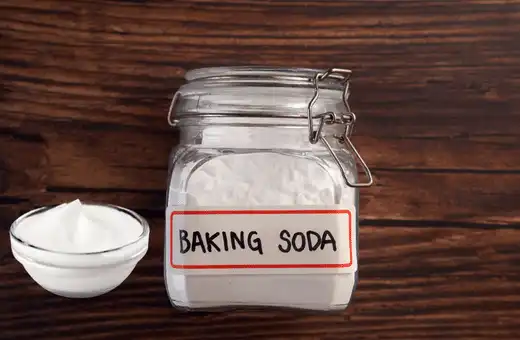
Check More- Vegan substitution for Yogurt
5.BUTTERMILK+BAKING SODA
Substitute buttermilk +baking soda for baking powder. It will make the cake denser.
If you’re looking for a way to make your cake denser, try substituting buttermilk + baking soda for baking powder. This simple change can result in a more moist and flavorful cake.
Just be sure to adjust the other ingredients accordingly so that your cake doesn’t end up too dry or crumbly.
6. CREAM OF TARTAR+BAKING SODA
To replace the baking powder with cream of tartar and baking soda, use one part cream of tartar to two parts baking soda. For example, instead of 1 tablespoon baking powder, use 1/2 tablespoon cream of tartar and 1 tablespoon baking soda.
Keep in mind that this substitution will also change the acidity level of your recipe, so it’s best to only use this swap in recipes that are tolerant of a little extra acidity.
Don not confused it with tartar sauce and cream of tartar.
7. CLUB SODA
Baking powder is an ingredient commonly found in cakes, cookies, and other baked products. But did you know that club soda can be used in place of baking powder?
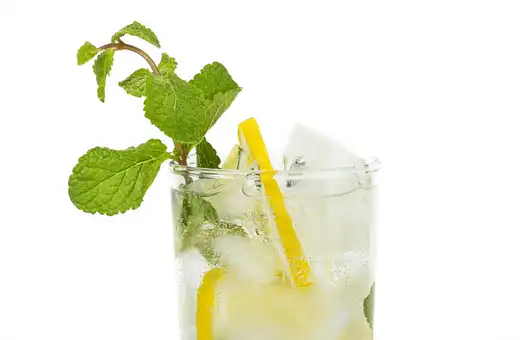
That’s right! Club soda can be used as a 1:1 replacement for baking powder. So if your recipe calls for 1 teaspoon of baking powder, simply use 1 teaspoon of club soda instead. This substitution is particularly useful when making cookies, as it helps to prevent them from spreading too much.
Not only is this substitution easy to remember, but it can also help to extend the life of your baking powder. Baking powder tends to lose its potency over time, so using club soda can help to ensure that your baked goods always turn out perfectly.
So, the next time you’re in a pinch, remember that club soda can be used in place of baking powder. It’s an easy way to get perfect results every time!
Check More- Best substitute for Club Soda
8. Self-rising flour Instead of Baking Powder
If you find yourself in a pinch and don’t have any baking powder on hand, you can easily substitute self-rising flour for the baking powder called for in a recipe.
Just remember that since self-rising flour already contains baking powder, you’ll want to use about one-third less than the recipe calls for.
So, if a recipe calls for 3 teaspoons of baking powder, use 1 teaspoon of self-rising flour instead.
9. MOLASSES WITH BAKING SODA
Molasses can also be substituted for honey or syrup. When substituting molasses for baking powder, use one tablespoon of molasses for every teaspoon of baking powder.
Be sure to decrease the amount of liquid in the recipe by three tablespoons for every tablespoon of molasses used. Molasses can also be used in place of honey or syrup.
When using molasses as a sweetener, use one-third cup of molasses for every cup of sugar called for in the recipe. Again, for every tablespoon of molasses used, reduce the amount of liquid in the recipe by three tablespoons. Many baking recipes use whipped egg whites as a leavening agent.
10. Whipped egg whites- A Homemade substitute for baking powder
When baking, many recipes call for whipped egg whites as a leavening agent. However, store-bought egg whites can be expensive, and not everyone keeps them on hand. If you find yourself in a bind and need a quick substitute for whipped egg whites, there are a few things you can do.
One option is to use an equal amount of cream of tartar. This will add some volume and lightness to your baked goods, but it won’t give them the same structure as egg whites. You could also use club soda or seltzer water.
Just add enough to equal the number of egg whites called for in your recipe. The carbonation will help your baked goods rise and give them a light, airy texture.
If you have some more time, you can also prepare your own whipped egg whites. Just beat some eggs until the whites are stiff, and then fold in a bit of cream of tartar or sugar. This will give you a stable whipped egg white that will work well in most recipes.
So, next time your recipe calls for whipped egg whites, and you don’t have any on hand, don’t panic! There are numerous alternatives that will perform just as well.
Check More- Best Egg Substitutes for Ice cream ( Vegan)
11. Yeast – Good Substitute for Baking Powder
The easiest and most handy baking powder substitution is yeast. Yeast is always known as a great leaving agent. So, yeast very much goes with bread or muffin instead of baking powder, also cookies, cakes, biscuits, and other baked goods.
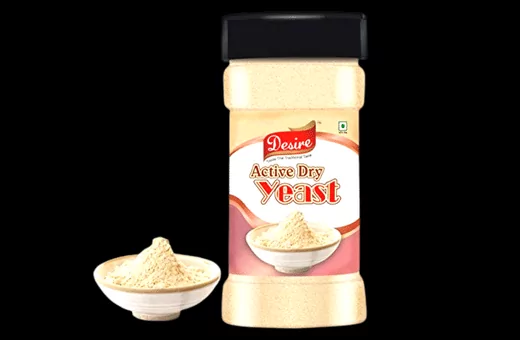
The best part of using yeast is- It minimizes the leaving timing, and the process goes faster than before.
Read More- Yeast Nutrient Substitutes
FAQs on cornstarch & Baking Powder
Q1. Can I use baking soda instead of baking powder?
Yes, you can use baking soda instead of baking powder, but you will need to adjust the number of other ingredients in your recipe like sour cream, vinegar, molasses, buttermilk, and so on. Baking soda is a more powerful leavening agent than baking powder, so you will need to use less of it.
You should also be aware that adding baking soda to your baked goods will alter their flavor and texture.
Q2. How much vinegar do I substitute for baking powder?
You can try using a combination of 1 part vinegar to 2 parts cream of tartar. This will give some leavening power to your baked goods, but they may not rise as much as they would with traditional baking powder.
You can also try other acidic components, such as lemon juice or yoghurt.
Q3. What happens if I forget baking powder for a cake?
If you don’t use baking powder, your cake will be dense and won’t rise. There are a few options for saving a cake that lacks baking powder. One method is to use 1/4 teaspoon of cream of tartar for every cup of flour.
Another way is to separate the eggs and add 1/2 tsp of baking powder for each egg white.
Finally, try substituting 1/4 cup of self-rising flour for each cup of all-purpose flour.
Q4. What happens if you don’t have baking powder?
Baking powder is one of the key ingredients for baking. So you don’t have baking powder, do not worry; you can use any substitution instead of it, including- Yeast, Club soda, Vinegar+baking soda, lemonjuice+baking soda, self-rising flour, and so many others I already mentioned above.
Q5. Does cornstarch help cake rise?
No, cornstarch does not help a cake to rise. But When combined with baking powder, it creates a leavening effect that helps the cake to rise and become fluffy. Cornstarch is good at thickening sauces and gravy.
Q6. Can I use baking soda instead of baking powder for the cake?
Yes, you can use baking soda instead of baking powder for the cake. The ratio is 1:3, so for every 1 teaspoon of baking powder, use 3 teaspoons of baking soda. Additionally, be sure to add an acid to your recipe when using baking soda as a leavening agent.
This will help neutralize the sodium bicarbonate and produce a better rise in your cake. Try adding lemon juice, vinegar, or cream of tartar to your recipe.
Q7. Is cornstarch the same as baking powder?
No, cornstarch and baking powder are not the same. Cornstarch is a fine, powdery starch made from corn, while baking powder is a leavening agent that helps baked goods rise. Both can be used as thickeners, but they have different uses in cooking and baking.
Cornstarch is best used as a thickener for sauces, gravies, and pies, while baking powder is typically used in baked goods.

